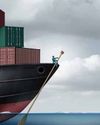
Making a welcome departure from the policy and infrastructure related issues that have been discussed in the past editions of Containers India, this year the mega summit brought the most controversial issue onto the center stage – “the cost of logistics.” Elaborating more on the topic Ramprasad, Editor-in-Chief and Publisher, Maritime Gateway said, “When we started Containers India we were discussing several policy related issues such as Cabotage, need for more container terminals, movement of cargo – whether it is more towards the east side?, the mushrooming of CFSs - will it help the trade?, DPD and several issues. So when I look back at the transition that is happening in the discussions, this year’s topic in consultation with CSLA and other stakeholders, we finally arrived at the most important thing which even the government is discussing – the cost of logistics.” The first session focused on “Reducing cost – are we looking at the wrong tree?,” which essentially means that in our value chain every stakeholder is a service provider for other stakeholder and when it comes to the cost everybody says the other person is responsible for making logistics very costly, so the first session tried to demystify where the cost is actually getting escalated?
The second session was “Empowering the end customer,” how the industry is serving him and what kind of transparency service providers are providing? The third session discussed digitalisation. For the past couple of years digitalisation has been at the forefront in our sector. Several organisations are independently making efforts to bring digitalisation as an enabler for customer service.
この記事は Maritime Gateway の October 2019 版に掲載されています。
7 日間の Magzter GOLD 無料トライアルを開始して、何千もの厳選されたプレミアム ストーリー、9,000 以上の雑誌や新聞にアクセスしてください。
すでに購読者です ? サインイン
この記事は Maritime Gateway の October 2019 版に掲載されています。
7 日間の Magzter GOLD 無料トライアルを開始して、何千もの厳選されたプレミアム ストーリー、9,000 以上の雑誌や新聞にアクセスしてください。
すでに購読者です? サインイン

Impact Of Covid-19 On Shipping And Logistics
Industry stalwarts discuss threadbare the prevailing logistics and supply chain scenario and issues in clearing cargo during the COVID-19 lockdown

Digital Platforms Defy Lockdown
Digital trading modules such as eNAM are enabling farmers to move their produce from farm to market even during the lockdown

GARMENT TRADE TRAMPLED
As retailers face a shutdown in US and Europe, the cascading affect has caused mass cancellation of orders in Bangladesh

TRADE RESUMES WITH CHINA
While India has allowed uninterrupted movement of imports into Nepal even during lockdown, China is reopening its borders as it emerges from the pandemic
LESS HUMAN INTENSIVE, MORE DATA DRIVEN
AI provides transformational opportunity for logistics industry by improving customer experience, operational efficiency, faster turnaround time and lower cost while ensuring security and transparency. Macro environment requires industry to transform to be less human intensive, agile and data driven, all of which can be accelerated by AI adoption, shares Gangadhar Gude, Founder & CEO, atai.ai

SHAKEN AND STIRRED
The COVID-19 pandemic has partially paralysed the logistics and supply chain, but the industry is still deterred to ensure supply of essentials continues

TRADE STUCK, ECONOMY SLOWS DOWN
Sri Lankan economy slows down as trade deficit widens and supply chain disrupts amidst lockdown

LENDING INTELLIGENCE TO SUPPLY CHAIN
If you’re shipping millions of dollars’ worth of pharmaceuticals, high-end electronics, expensive seafood, or precious metals, what would you be willing to pay for the ability to ‘ask’ your shipment where it is right now and whether it’s ok? What would you pay for a freight smart enough to raise an alarm before it spoils? Artificial Intelligence enables that and much more…

CONTAINER LINES SIGNAL ‘SOS'
As the per-unit cost of operations increases many lines are forced to blank sailings which has hit their bottom line real hard. The Government and Terminal Operators therefore need to actively consider reduction in Vessel Related Costs

IMO 2020 And The Covid-19 Curse
The COVID-19 outbreak has shaken and stirred the already volatile bunker market. While the refiners adjust their capacities and shipping lines choose their path to compliance, the market dynamics are yet to reach an equilibrium